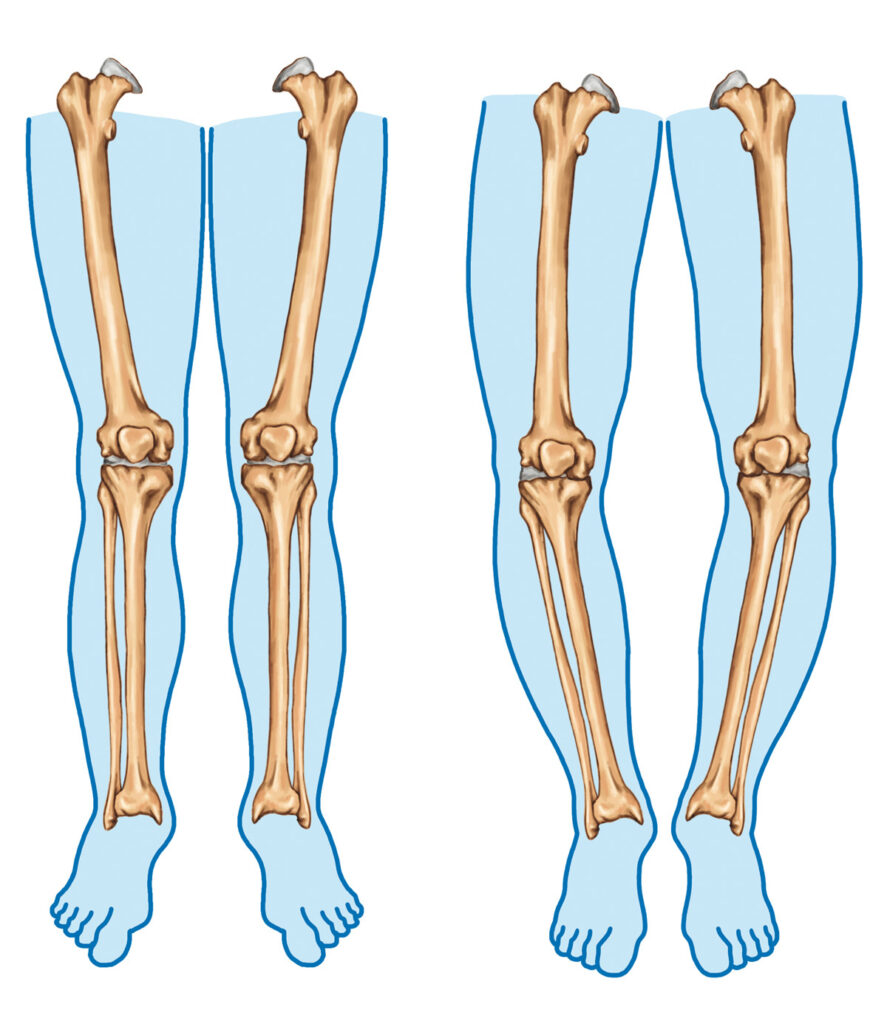Bow Leg Correction

Symptoms
In most cases, the symptoms are similar: there is a space between the knees even when the feet and ankles are touching. Patients who have bowlegs have reduced range of motion in the knees and may complain of pain in the knees and ankles. Even if your bow legs are functional and don’t affect mobility, bow legs correction can be important to reduce pain and to prevent future problems.
Muscles work in pairs. In conditions like bow legs, muscle strength is uneven, which can affect the hip, knee and ankle joints and cause pain. Bow legs put extra pressure on the inside of the knee and over time, can increase the risk of osteoarthritis. If you are overweight and have bow legs, that puts even more stress on the joints in the legs, which can make joint pain worse. Eventually the cartilage in the joints, especially the knees, begins to deteriorate, allowing the bones to rub together. Bow legs can also change your overall posture and may lead to back pain. Finally, it may be a cosmetic issue and affect your self-esteem.
Diagnosis
The diagnosis of bow legs is relatively simple. A physical examination and analysis of the patient’s gait patterns make it easy to see the deformity. X-rays are also of value in determining how severe the condition is and whether there is bone damage. Since the cause can affect treatment, doctors usually perform blood tests and other imaging studies to check for rickets, Paget’s disease or other metabolic conditions related to bow legs.
Treatment
Treatment of bow legs varies according to the underlying cause, patient’s age and severity of the deformity. Treatment options consist of conservative measures such as special shoes, braces and casts. However, a surgery called an osteotomy is often the most effective treatment. Surgery is the preferred treatment if the patient doesn’t respond to conservative therapy, if the deformity is severe, or in older adolescents and adults who were not treated as children.
The most common procedure is a tibial osteotomy. The shinbone is cut with a one-half inch incision just below the knee and reshaped; this corrects the alignment problem and straightens the leg. In most cases, the shinbone is held in alignment with a special device. The external fixator is applied to the outside of the leg through one-quarter inch incisions. This fixator helps to strengthen the leg and aids in supporting the bone as it heals. Patients who have this procedure done don’t need a cast or crutches and can bear weight immediately after surgery. Healing generally takes about two months; scarring is minimal and often disappears over time. Most people are able to be active with crutches throughout the healing phase.The procedure is a short one – approximately one hour, with a one-night hospital stay. Most patients report that knee pain is relieved by the surgery and that the surgery itself causes little pain. Another benefit is that the surgery may also add about half an inch in length to the leg.
Physical therapy is required and you will need to use crutches for several months. Exercise continues to be important during the recovery phase after surgery, as the muscles have typically adjusted to the bowlegs and are uneven. Exercise also promotes circulation and wound healing.
Bow legs can cause knee pain as well as a number of associated problems such as cartilage loss. Bow-leggedness can lead to other problems as you get older, including degenerative conditions in the knee and hip joints. It may also cause pain in the knees, hips or ankles due to poor alignment of the joints.
Preparing for the Surgery
As with all surgical procedures, you should have a thorough medical examination to rule out possible problems prior to surgery. If you smoke, stop at least two weeks before the surgery. Many surgeons recommend scrubbing the surgical area daily to reduce bacteria that might cause infection. Provide the doctor with a list of all your medications. A preoperative exercise program can promote knee strength and range of motion.
